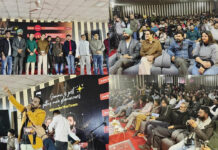On Day 4 of Chaitra Navratri, devotees offer prayers to Maa Kushmanda, the fourth form of Goddess Durga. Her name is derived from three Sanskrit words: “Ku” meaning “a little,” “Ushma” meaning “warmth,” and “Anda” meaning “cosmic egg.” Together, her name translates to “the one who created the universe with a little warmth.” According to Hindu mythology, it is believed that Maa Kushmanda created the universe with her divine smile, which gave birth to a small cosmic egg from which the entire cosmos emerged.
Maa Kushmanda is traditionally depicted with eight arms, holding various weapons and symbols that signify power and protection. She is said to reside in the center of the sun, controlling the energy and light that flows through the universe. Her radiant aura is symbolic of the warmth, positivity, and life she spreads across creation. Devotees seek her blessings for good health, happiness, and prosperity, as well as for removing darkness and ignorance from their lives.
Chaitra Navratri 2024 Day 4: Date and Shubh Muhurat
In 2024, the fourth day of Chaitra Navratri will be celebrated on Friday, April 12. The auspicious timings for conducting puja and observing rituals on this day, according to Drik Panchang, are as follows:
Chaturthi Tithi: Begins at 1:11 PM on April 12
Moonrise: 9:07 PM on April 12
Vijaya Muhurat: From 2:26 PM to 5:15 PM on April 12
Ravi Yoga: Begins at 12:51 AM on April 13 and ends at 6:14 AM on April 13
Performing the puja during these auspicious hours is considered highly beneficial for invoking the blessings of Maa Kushmanda and ensuring a successful observance of the vrat (fast).
Day 4 Colour: Green
The fourth day of Chaitra Navratri is associated with the colour green, symbolizing nature, growth, fertility, and serenity. Green is also seen as a representation of new beginnings, making it an ideal colour for this day of worship. Devotees believe that wearing green on Day 4 helps invoke the blessings of Maa Kushmanda, bringing peace and prosperity into their lives. The colour is also linked to healing and harmony, resonating with the goddess’s nurturing and protective qualities.
Puja Vidhi and Rituals for Maa Kushmanda
To honour Maa Kushmanda on the fourth day of Chaitra Navratri, devotees perform special rituals and follow a set of traditional puja practices. Here’s a step-by-step guide to conducting the puja:
- Begin with Ganesh Puja: As with all Hindu rituals, the worship of Lord Ganesha is performed first to remove any obstacles and ensure the smooth observance of the Navratri vrat (fast).
- Invoke Maa Kushmanda: Light a diya (lamp) and place it in front of the idol or image of Maa Kushmanda. Offer her flowers, particularly marigolds, as they are considered auspicious. Recite her mantra with devotion:
(Om Aim Hreem Kleem
Kushmandayai Namah). - Offer Traditional Ornaments: A significant part of the worship involves offering various traditional ornaments to the goddess. These include sindoor (vermillion), mehendi (henna), kajal (kohl), bindi, bangles, toe rings, combs, alta (red dye), mirrors, anklets, perfume, earrings, nose pins, necklaces, red chunri (cloth), mahavar (red dye for feet), and hairpins. These ornaments symbolize feminine strength and beauty.
- Prepare Prasad: Offerings of Malpuas, halwa, or curd are prepared as prasad (holy food). These dishes are later offered to the priests at a Durga temple as a gesture of reverence. It is believed that distributing prasad to others, especially the needy, brings divine blessings.
- Recite Durga Saptashati: Reciting the Durga Saptashati, a collection of 700 verses in praise of Goddess Durga, is considered highly meritorious. This can be done during the puja to invoke the goddess’s blessings for strength and protection.
- Observe Fast (Vrat): Many devotees observe a fast on this day, abstaining from grains and consuming fruits, milk, and other sattvic (pure) foods. It is believed that fasting with devotion purifies the mind and body, bringing one closer to the divine.
- End with Aarti: The puja concludes with an Aarti (ritual of worship with a lamp), singing praises to Maa Kushmanda and seeking her blessings for the well-being of the family.
The Significance of Worshipping Maa Kushmanda
Worshipping Maa Kushmanda is believed to bring positivity, health, and happiness to devotees’ lives. She is considered the source of all creation, and by offering prayers to her, one is thought to gain the power to overcome obstacles and face challenges with strength and resilience.
Her blessings are particularly sought for overcoming ailments, mental health struggles, and financial difficulties. She is also believed to remove all forms of negativity and ill luck, replacing them with light, wisdom, and prosperity. Her radiant energy is said to rejuvenate the mind and soul, filling one’s life with happiness and joy.
Chaitra Navratri Day 4 is a special day dedicated to Maa Kushmanda, the goddess who created the universe with her divine energy. Observing the day with devotion, performing the puja with the right rituals, and wearing green to symbolize growth and new beginnings can bring the blessings of health, happiness, and prosperity into one’s life.
As the festival progresses, the worship of each form of Goddess Durga serves to remind devotees of the different facets of life, helping them seek balance and strength in their spiritual journey.






























